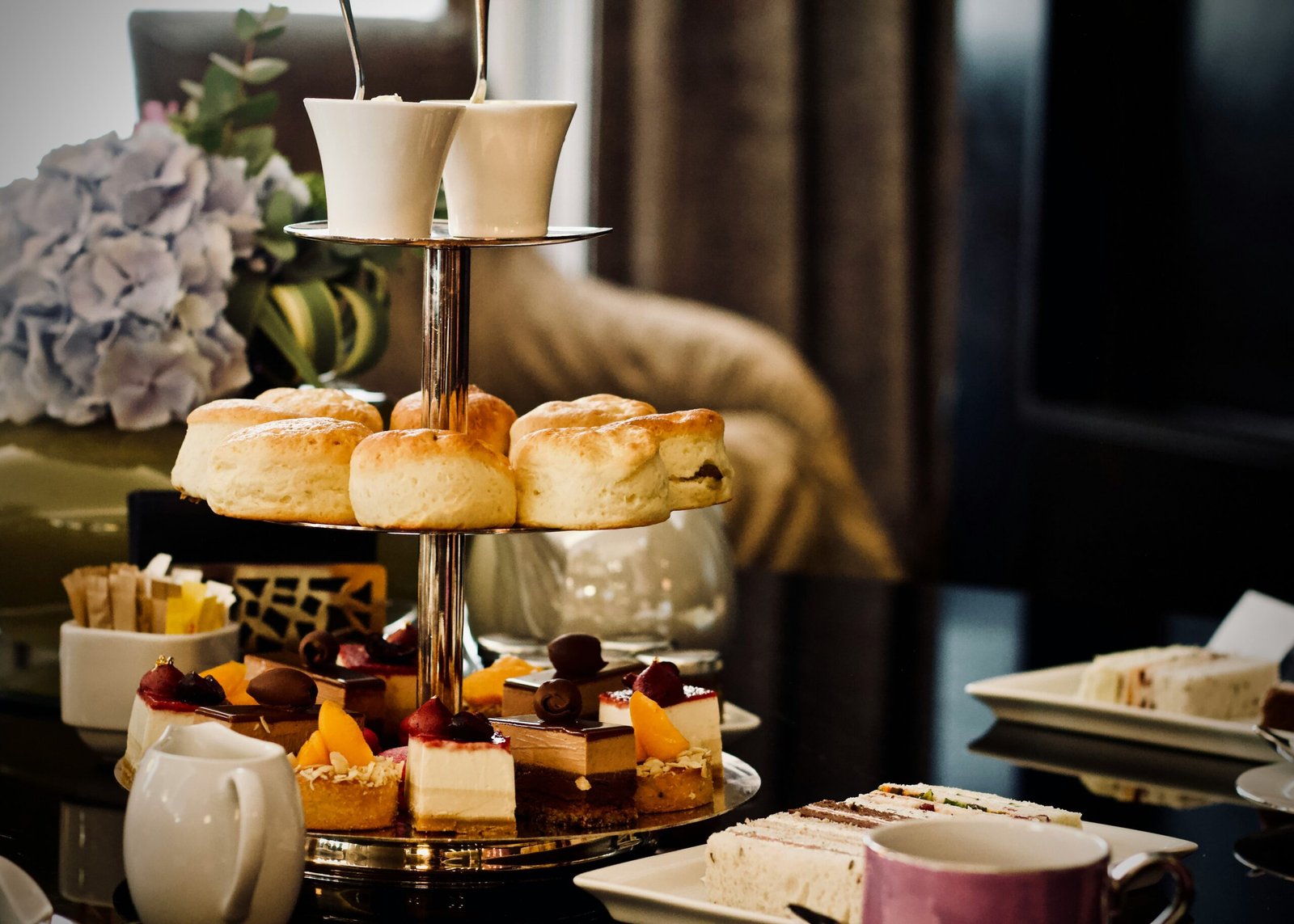The Origins of Afternoon Tea
The tradition of afternoon tea dates back to the early 1840s in Britain. It is believed that the Duchess of Bedford, Anna, initiated this delightful ritual. During the Victorian era, it was common for people to have only two meals a day – breakfast and dinner. The long gap between these meals often left the Duchess feeling hungry and tired. To combat this, she started requesting a tray of tea, bread, and butter to be brought to her room in the late afternoon.
As the Duchess continued this practice, she began inviting friends to join her for tea and light refreshments. What started as a simple solution to her hunger pangs soon became a fashionable social gathering. The popularity of afternoon tea spread among the upper classes, and it became a way for women to socialize and network.
The Etiquette of Afternoon Tea
Participating in afternoon tea has its own set of etiquette rules that add to the charm and elegance of the experience. When attending a traditional afternoon tea, it is important to remember a few key points:
- Dress Code: Afternoon tea is a formal affair, so it is customary to dress appropriately. Women often wear dresses or skirts, while men opt for suits or smart-casual attire.
- Seating Arrangement: When seated at the table, it is polite to wait until everyone is present before starting. The host or hostess usually takes the seat facing the door, while guests are seated in a clockwise direction.
- Tea Selection: The choice of tea is an essential part of afternoon tea. Traditional options include Earl Grey, English Breakfast, and Darjeeling. It is customary to pour the tea first and then add milk or lemon according to personal preference.
- Food Etiquette: Afternoon tea is accompanied by a selection of sandwiches, scones, and pastries. It is important to eat these delicacies in a specific order. Start with the sandwiches, followed by scones with clotted cream and jam, and finish with the pastries.
Must-Try Delicacies
No afternoon tea experience is complete without indulging in a variety of delectable treats. Here are some must-try delicacies:
- Scones: These warm, fluffy pastries are a quintessential part of afternoon tea. Served with clotted cream and strawberry jam, they are a delightful combination of sweet and savory.
- Cucumber Sandwiches: Thinly sliced cucumbers placed between two slices of buttered bread make for a refreshing and light sandwich option.
- Victoria Sponge Cake: This classic British cake consists of two layers of sponge cake filled with jam and whipped cream. It is a heavenly treat that pairs perfectly with a cup of tea.
- Macarons: These delicate French pastries are often included in afternoon tea menus for their vibrant colors and irresistible flavors.
So, whether you are a tea connoisseur or a curious traveler, experiencing British afternoon tea is a must. It offers a glimpse into the rich history and traditions of British culture, while treating your taste buds to an array of delightful flavors. Join us on this journey of Tea Time Tales as we dive deeper into the world of afternoon tea.
The popularity of afternoon tea grew rapidly, spreading beyond the upper class and becoming a cherished tradition for people of all social backgrounds. It became a way for friends and family to gather and enjoy each other’s company in a relaxed and intimate setting.
As the tradition evolved, so did the etiquette and customs associated with afternoon tea. The serving of tea was no longer limited to just the Duchess’s private quarters; it became a formal affair, often held in elegant tea rooms or the drawing rooms of grand homes. Elaborate tea sets, fine china, and delicate silverware were used to create an atmosphere of refinement and sophistication.
Alongside the tea, a variety of delectable treats were served. Finger sandwiches with fillings like cucumber and smoked salmon, scones with clotted cream and jam, and a tempting array of pastries and cakes adorned the table. The presentation of these delicacies became an art form in itself, with each item meticulously arranged on tiered cake stands and delicate china plates.
The afternoon tea experience was not just about the food and drink; it was also about the rituals and traditions that accompanied it. Tea was brewed in a teapot and served in delicate teacups, often accompanied by a milk jug and sugar bowl. The tea was poured first, followed by a splash of milk or a sugar cube, according to one’s preference. Stirring the tea was considered a delicate task, done with a gentle back-and-forth motion rather than a circular one.
As the years went by, afternoon tea became a symbol of British culture and hospitality. It became a way for people to take a break from their busy lives and indulge in a moment of relaxation and indulgence. The tradition even made its way across the Atlantic to America, where it was embraced and adapted to suit the American palate.
Today, afternoon tea continues to be a beloved tradition in many parts of the world. Whether enjoyed in a charming tea room, a luxurious hotel, or the comfort of one’s own home, it is a delightful way to connect with loved ones and savor the simple pleasures of life.
Engaging in Polite Conversation
While enjoying your afternoon tea, it is important to engage in polite conversation with your fellow tea-goers. Avoid discussing controversial topics or anything that may cause discomfort. Instead, focus on light-hearted and pleasant topics such as current events, hobbies, or travel experiences. Remember to listen attentively to others and show genuine interest in their stories.
Minding Your Manners
Etiquette extends beyond just the food and drink at afternoon tea. It is essential to mind your manners throughout the entire experience. Use your utensils properly, keeping your elbows off the table and chewing with your mouth closed. Avoid reaching across the table and instead, politely ask for items to be passed to you. If you need to excuse yourself, do so discreetly and wait for a break in the conversation.
Expressing Gratitude
Afternoon tea is often hosted by someone who has taken the time and effort to prepare a delightful experience for guests. It is essential to express your gratitude for their hospitality. A simple thank you to the host or hostess is customary, and if you feel inclined, you may send a handwritten note or small gift as a token of appreciation following the event.
Parting Ways
When the afternoon tea comes to an end, it is polite to thank your fellow tea-goers for their company and bid them farewell. Stand up from the table gracefully and thank the host or hostess once again for their hospitality. Remember to leave your seating area clean and tidy, and if necessary, offer to assist with clearing any remaining dishes or utensils.
By observing these etiquettes, you can fully immerse yourself in the elegance and charm of a traditional British afternoon tea. Enjoy the delicious treats, engage in pleasant conversation, and leave a lasting impression as a gracious tea-goer.
Must-Try Delicacies
No afternoon tea experience is complete without sampling some of the classic delicacies. Here are a few must-try treats:
Scones
A quintessential part of British afternoon tea, scones are a deliciously crumbly pastry that is traditionally served with clotted cream and jam. Whether you prefer plain scones or ones with added fruit such as raisins or currants, they are sure to delight your taste buds.
Finger Sandwiches
Delicate finger sandwiches are another staple of afternoon tea. Typically made with crustless bread, they come in various flavors such as cucumber and cream cheese, smoked salmon, or egg and cress. These bite-sized sandwiches are a perfect balance of flavors and textures.
Pastries and Cakes
No afternoon tea is complete without a selection of pastries and cakes. From dainty éclairs and macarons to rich chocolate cakes and fruity tarts, there is something to satisfy every sweet craving. Be sure to try a little bit of everything!
In addition to these classic delicacies, many afternoon tea menus also offer a variety of other treats to tantalize your taste buds. One such treat is the Victoria sponge cake, a light and airy sponge cake layered with jam and cream. This cake is a true British classic and is often enjoyed alongside the scones and finger sandwiches.
For those who prefer a more savory option, quiches and savory tarts are often included in afternoon tea menus. These savory pastries are filled with ingredients such as cheese, vegetables, or meat, and offer a delightful contrast to the sweetness of the other treats.
Another popular delicacy to try is the Battenberg cake. This unique cake is made up of alternating squares of pink and yellow sponge cake, which are then wrapped in marzipan. It not only looks beautiful but also has a delicious almond flavor that pairs perfectly with a cup of tea.
If you’re feeling adventurous, you may also want to try some traditional tea sandwiches. These sandwiches are made with thinly sliced bread and filled with a variety of fillings such as smoked salmon, cucumber, or even thinly sliced roast beef. They are often cut into delicate triangles or squares and are a delightful addition to any afternoon tea spread.
Lastly, no afternoon tea would be complete without a selection of teas to choose from. Whether you prefer a classic Earl Grey, a fragrant jasmine tea, or a refreshing herbal infusion, there is a tea to suit every taste. Be sure to take your time and savor the flavors of each tea as you indulge in the delicious delicacies of the afternoon tea experience.
Modern Takes on Afternoon Tea
While the traditional British afternoon tea remains a beloved classic, modern variations have emerged to cater to different tastes and preferences. Here are a few examples of modern takes on afternoon tea:
Champagne Afternoon Tea
For those looking to add a touch of luxury to their afternoon tea experience, champagne afternoon tea is the perfect choice. Enjoy a glass of bubbly alongside your tea and indulge in a selection of treats that pair perfectly with the effervescence of champagne.
Asian-Inspired Afternoon Tea
With the growing popularity of Asian cuisine, many establishments now offer Asian-inspired afternoon teas. Expect to find delights such as matcha-flavored pastries, steamed buns filled with savory fillings, and exotic tea blends from countries like China and Japan.
Vegetarian or Vegan Afternoon Tea
As dietary preferences and requirements evolve, so do the offerings for afternoon tea. Vegetarian and vegan afternoon teas are becoming increasingly popular, with creative plant-based alternatives to traditional treats. Indulge in vegan scones, dairy-free cream, and a variety of plant-based sandwiches and pastries.
Gluten-Free Afternoon Tea
For those with gluten sensitivities or celiac disease, gluten-free afternoon tea options are now available. Enjoy a selection of gluten-free pastries, cakes, and sandwiches that are just as delicious as their gluten-filled counterparts. From almond flour scones to flourless chocolate cake, these treats will satisfy any sweet tooth.
Afternoon Tea with a Twist
For those looking for a unique twist on the traditional afternoon tea, there are options that offer a fusion of flavors and cuisines. Imagine enjoying a Mexican-inspired afternoon tea with mini tacos, churros, and spicy tea blends. Or perhaps a Mediterranean-themed tea with hummus-filled sandwiches, olive oil-infused pastries, and refreshing herbal teas.
These modern takes on afternoon tea provide an opportunity to explore new flavors and experiences while still enjoying the elegance and tradition of this beloved ritual. Whether you prefer a classic British tea or one with a contemporary twist, there is a modern afternoon tea to suit every taste.


